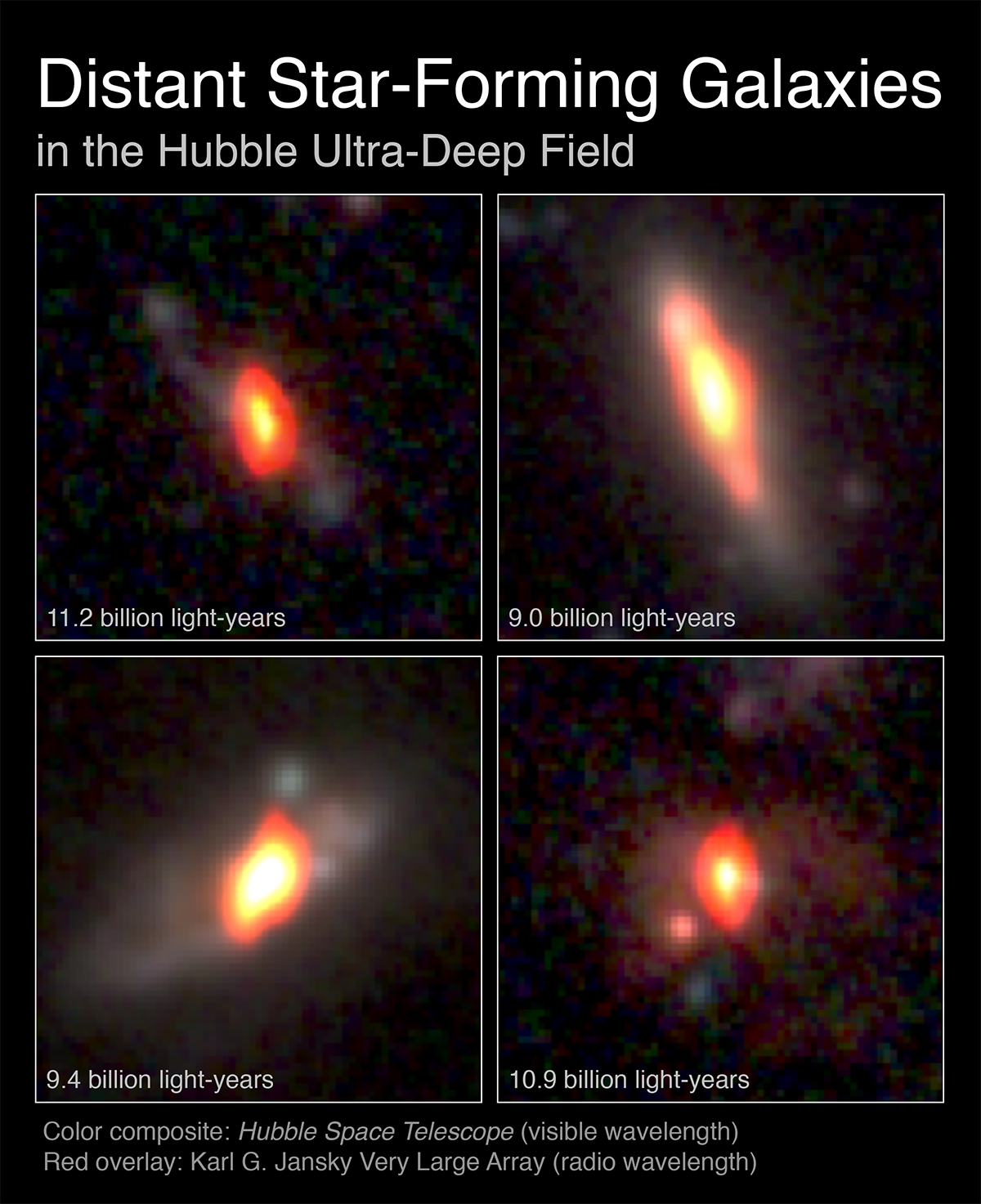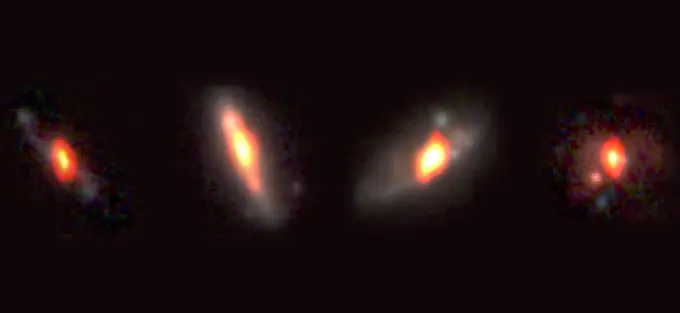VLA and ALMA Team Up to Give First Look at Birthplaces of Most Current Stars
Astronomers have gotten their first look at exactly where most of today's stars were born. To do so, they used the National Science Foundation's Karl G. Jansky Very Large Array (VLA) and the Atacama Large Millimeter/submillimeter Array (ALMA) to look at distant galaxies seen as they were some 10 billion years ago.
At that time, the Universe was experiencing its peak rate of star formation. Most stars in the present Universe were born then.
"We knew that galaxies in that era were forming stars prolifically, but we didn't know what those galaxies looked like, because they are shrouded in so much dust that almost no visible light escapes them," said Wiphu Rujopakam, of the Kavli Institute for the Physics and Mathematics of the Universe at the University of Tokyo and Chulalongkorn University in Bangkok, who was lead author on the research paper.
Radio waves, unlike visible light, can get through the dust. However, in order to reveal the details of such distant and faint galaxies, the astronomers had to make the most sensitive images ever made with the VLA.
The new observations, using the VLA and ALMA, have answered longstanding questions about just what mechanisms were responsible for the bulk of star formation in those galaxies. They found that intense star formation in the galaxies they studied most frequently occured throughout the galaxies, as opposed to much smaller regions in present-day galaxies with similar high star-formation rates.

Radio/Optical combination images of distant galaxies as seen with NSF's Very Large Array and NASA's Hubble Space Telescope. Their distances from Earth are indicated in the top set of images. Credit: K. Trisupatsilp, NRAO/AUI/NSF, NASA. | Download image
The astronomers used the VLA and ALMA to study galaxies in the Hubble Ultra Deep Field, a small area of sky observed since 2003 with NASA's Hubble Space Telescope (HST). The HST made very long exposures of the area to detect galaxies in the far-distant Universe, and numerous observing programs with other telescopes have followed up on the HST work.
"We used the VLA and ALMA to see deeply into these galaxies, beyond the dust that obscured their innards from Hubble," said Kristina Nyland, of the National Radio Astronomy Observatory (NRAO). "The VLA showed us where star formation was occurring, and ALMA revealed the cold gas that is the fuel for star formation," she added.
"In this study, we made the most sensitive image ever made with the VLA," said Preshanth Jagannathan, also of NRAO. "If you took your cellphone, which transmits a weak radio signal, and put it at more than twice the distance to Pluto, near the outer edge of the Solar System, its signal would be roughly as strong as what we detected from these galaxies," he added.
Additional information
This research is presented in a paper titled “VLA And ALMA Imaging of Intense, Galaxy-Wide Star Formation in z ∼ 2 Galaxies” by Rujopakarn et al., published in the Astrophysical Journal.
The research team is composed by W. Rujopakarn [1,2], J. S. Dunlop [3], G. H. Rieke [4], R. J. Ivison [3,5], A. Cibinel [6], K. Nyland [7], P. Jagannathan [8], J. D. Silverman [1], D. M. Alexander [9], A. D. Biggs [5], S. Bhatnagar [8], D. R. Ballantyne [10], M. Dickinson [11], D. Elbaz [12], J. E. Geach [13], C. C. Hayward [14,15], A. Kirkpatrick [16], R. J. McLure [3], M. J. Michałowski [3], N. A. Miller [17], D. Narayanan [18], F. N. Owen [8], M. Pannella [19], C. Papovich [20], A. Pope [21], U. Rau [8], B. E. Robertson [22], D. Scott [23], A. M. Swinbank [9], P. van der Werf [24], E. van Kampen [5], B. J. Weiner [4], and R. A. Windhorst [25].
[1] Kavli Institute for the Physics and Mathematics of the universe (WPI), The University of Tokyo Institutes for Advanced Study, The University of Tokyo, Kashiwa, Chiba 277-8583, Japan.
[2] Department of Physics, Faculty of Science, Chulalongkorn University, 254 Phayathai Road, Pathumwan, Bangkok 10330, Thailand.
[3] Institute for Astronomy, University of Edinburgh, Royal Observatory, Blackford Hill, Edinburgh EH9 3HJ, UK.
[4] Steward Observatory, University of Arizona, Tucson, AZ 85721, USA.
[5] European Southern Observatory, Karl-Schwarzschild-Straße 2, Garching, Germany.
[6] Astronomy Centre, Department of Physics and Astronomy, University of Sussex, Brighton, BN1 9QH, UK.
[7] National Radio Astronomy Observatory, Charlottesville, VA 22903, USA.
[8] National Radio Astronomy Observatory, Socorro, NM 87801, USA.
[9] Department of Physics, Durham University, Durham DH1 3LE, UK.
[10] Center for Relativistic Astrophysics, School of Physics, Georgia Institute of Technology, Atlanta, GA 30332, USA.
[11] National Optical Astronomy Observatory, 950 North Cherry Avenue, Tucson, AZ 85719, USA.
[12] CEA Saclay, DSM/Irfu/Service d'Astrophysique, Orme des Merisiers, F-91191 Gif-sur-Yvette Cedex, France.
[13] Center for Astrophysics Research, Science & Technology Research Institute, University of Hertfordshire, Hatfield AL10 9AB, UK.
[14] Center for Computational Astrophysics, 160 Fifth Avenue, New York, NY 10010, USA.
[15] Harvard-Smithsonian Center for Astrophysics, 60 Garden Street, Cambridge, MA 02138, USA.
[16] Yale Center for Astronomy & Astrophysics, Physics Department, P.O. Box 208120, New Haven, CT 06520, USA.
[17] Department of Mathematics and Physical Sciences, Stevenson University, Stevenson, MD 21153-0641, USA.
[18] Department of Astronomy, University of Florida, Gainesville, FL 32611-2055, USA.
[19] Faculty of Physics, Ludwig-Maximilians Universität, Scheinerstraße 1, D-81679 Munich, Germany.
[20] Department of Physics and Astronomy, Texas A&M University, College Station, TX, 77843-4242 USA.
[21] Department of Astronomy, University of Massachusetts, Amherst, MA 01003, USA.
[22] Department of Astronomy and Astrophysics, University of California, Santa Cruz, CA 95064, USA.
[23] Department of Physics and Astronomy, University of British Columbia, 6224 Agricultural Road, Vancouver, BC, V6T1Z1 Canada.
[24] Leiden Observatory, Leiden University, PO Box 9513, 2300 RA Leiden, The Netherlands.
[25] School of Earth and Space Exploration, Arizona State University, Tempe, AZ 85287, USA.
The Atacama Large Millimeter/submillimeter Array (ALMA), an international astronomy facility, is a partnership of the European Organisation for Astronomical Research in the Southern Hemisphere (ESO), the U.S. National Science Foundation (NSF) and the National Institutes of Natural Sciences (NINS) of Japan in cooperation with the Republic of Chile. ALMA is funded by ESO on behalf of its Member States, by NSF in cooperation with the National Research Council of Canada (NRC) and the Ministry of Science and Technology (MOST) in Taiwan and by NINS in cooperation with the Academia Sinica (AS) in Taiwan and the Korea Astronomy and Space Science Institute (KASI).
ALMA construction and operations are led by ESO on behalf of its Member States; by the National Radio Astronomy Observatory (NRAO), managed by Associated Universities, Inc. (AUI), on behalf of North America; and by the National Astronomical Observatory of Japan (NAOJ) on behalf of East Asia. The Joint ALMA Observatory (JAO) provides the unified leadership and management of the construction, commissioning and operation of ALMA.
Contacts
-
Nicolás Lira
Education and Public Outreach CoordinatorJoint ALMA Observatory, Santiago - ChilePhone: +56 2 2467 6519Cel: +56 9 9445 7726Email: [email protected] -
Richard Hook
Public Information Officer, ESOGarching bei München, GermanyPhone: +49 89 3200 6655Cel: +49 151 1537 3591Email: [email protected] -
Charles E. Blue
Public Information OfficerNational Radio Astronomy Observatory Charlottesville, Virginia - USAPhone: +1 434 296 0314Cel: +1 202 236 6324Email: [email protected] -
Masaaki Hiramatsu
Education and Public Outreach Officer, NAOJ Chile

